
Chapter 17 Natural Resource and Energy Economics Answer Key
Multiple Choice Questions
1.
As of 2013, the world's population is approximately:
D.
1.2 trillion.
AACSB: Reflective Thinking
Accessibility: Keyboard Navigation
Blooms: Remember
Difficulty: 1 Easy
Learning Objective: 17-01 Explain why falling birthrates mean that we are not likely to run out of natural resources.
Topic: Resource supplies: doom or boom?
2.
Relative to 1800, the living standard of the average person today in the United States is
about _____ times higher.
AACSB: Reflective Thinking
Accessibility: Keyboard Navigation
Blooms: Remember
Difficulty: 1 Easy
Learning Objective: 17-01 Explain why falling birthrates mean that we are not likely to run out of natural resources.
Topic: Resource supplies: doom or boom?

3.
Relative to 1800, today in the world there are:
AACSB: Reflective Thinking
Accessibility: Keyboard Navigation
Blooms: Remember
Difficulty: 1 Easy
Learning Objective: 17-01 Explain why falling birthrates mean that we are not likely to run out of natural resources.
Topic: Resource supplies: doom or boom?
4.
Whose
An
Essay
on
the
Principle
of
Population
argued that human living standards could
only temporarily rise above subsistence?
AACSB: Reflective Thinking
Accessibility: Keyboard Navigation
Blooms: Remember
Difficulty: 1 Easy
Learning Objective: 17-01 Explain why falling birthrates mean that we are not likely to run out of natural resources.
Topic: Resource supplies: doom or boom?
5.
What is the relationship between living standards and birthrates?
AACSB: Reflective Thinking

Accessibility: Keyboard Navigation
Blooms: Remember
Difficulty: 1 Easy
Learning Objective: 17-01 Explain why falling birthrates mean that we are not likely to run out of natural resources.
Topic: Resource supplies: doom or boom?
6.
The total fertility rate necessary to keep the population constant is approximately equal
A.
1.0.
B.
1.5.
C.
2.1.
D.
3.0.
AACSB: Reflective Thinking
Accessibility: Keyboard Navigation
Blooms: Remember
Difficulty: 1 Easy
Learning Objective: 17-01 Explain why falling birthrates mean that we are not likely to run out of natural resources.
Topic: Resource supplies: doom or boom?
7.
The total fertility rate:
AACSB: Analytic
Accessibility: Keyboard Navigation
Blooms: Remember
Difficulty: 1 Easy
Learning Objective: 17-01 Explain why falling birthrates mean that we are not likely to run out of natural resources.
Topic: Resource supplies: doom or boom?

8.
If a country has a total fertility rate of 1.8, then all else equal we would expect:
AACSB: Analytic
Accessibility: Keyboard Navigation
Blooms: Analyze
Difficulty: 3 Hard
Learning Objective: 17-01 Explain why falling birthrates mean that we are not likely to run out of natural resources.
Topic: Resource supplies: doom or boom?
9.
A total fertility rate of 1.0 will cause the:
AACSB: Analytic
Accessibility: Keyboard Navigation
Blooms: Analyze
Difficulty: 3 Hard
Learning Objective: 17-01 Explain why falling birthrates mean that we are not likely to run out of natural resources.
Topic: Resource supplies: doom or boom?
10.
A rising standard of living will:
AACSB: Reflective Thinking

Accessibility: Keyboard Navigation
Blooms: Understand
Difficulty: 2 Medium
Learning Objective: 17-01 Explain why falling birthrates mean that we are not likely to run out of natural resources.
Topic: Resource supplies: doom or boom?
11.
Population will necessarily fall if the:
AACSB: Reflective Thinking
Accessibility: Keyboard Navigation
Blooms: Understand
Difficulty: 2 Medium
Learning Objective: 17-01 Explain why falling birthrates mean that we are not likely to run out of natural resources.
Topic: Resource supplies: doom or boom?
12.
Many demographers expect world population to:
AACSB: Reflective Thinking
Accessibility: Keyboard Navigation
Blooms: Remember
Difficulty: 1 Easy
Learning Objective: 17-01 Explain why falling birthrates mean that we are not likely to run out of natural resources.
Topic: Resource supplies: doom or boom?

13.
Rapid population growth since 1800 has occurred primarily because of:
AACSB: Reflective Thinking
Accessibility: Keyboard Navigation
Blooms: Remember
Difficulty: 1 Easy
Learning Objective: 17-01 Explain why falling birthrates mean that we are not likely to run out of natural resources.
Topic: Resource supplies: doom or boom?
14.
Which of the following statements is true about falling birthrates?
AACSB: Reflective Thinking
Accessibility: Keyboard Navigation
Blooms: Understand
Difficulty: 2 Medium
Learning Objective: 17-01 Explain why falling birthrates mean that we are not likely to run out of natural resources.
Topic: Resource supplies: doom or boom?

15.
Which of the following nations has a total fertility rate that would suggest that its next
generation will only be half the size of the current generation?
A.
Hong Kong.
AACSB: Reflective Thinking
Accessibility: Keyboard Navigation
Blooms: Remember
Difficulty: 1 Easy
Learning Objective: 17-01 Explain why falling birthrates mean that we are not likely to run out of natural resources.
Topic: Resource supplies: doom or boom?
16.
Which of the following is
not
considered by demographers to be part of the three-step
demographic transition?
AACSB: Reflective Thinking
Accessibility: Keyboard Navigation
Blooms: Remember
Difficulty: 1 Easy
Learning Objective: 17-01 Explain why falling birthrates mean that we are not likely to run out of natural resources.
Topic: Resource supplies: doom or boom?

17.
In which step of the demographic transition would we expect population to grow the
fastest?
AACSB: Reflective Thinking
Accessibility: Keyboard Navigation
Blooms: Remember
Difficulty: 1 Easy
Learning Objective: 17-01 Explain why falling birthrates mean that we are not likely to run out of natural resources.
Topic: Resource supplies: doom or boom?
18.
According to the concept of demographic transition:
AACSB: Reflective Thinking
Accessibility: Keyboard Navigation
Blooms: Understand
Difficulty: 2 Medium
Learning Objective: 17-01 Explain why falling birthrates mean that we are not likely to run out of natural resources.
Topic: Resource supplies: doom or boom?

19.
Which of the following, in order, describes the three steps of the demographic transition?
AACSB: Reflective Thinking
Accessibility: Keyboard Navigation
Blooms: Remember
Difficulty: 1 Easy
Learning Objective: 17-01 Explain why falling birthrates mean that we are not likely to run out of natural resources.
Topic: Resource supplies: doom or boom?
20.
Since 1850, the:
AACSB: Reflective Thinking
Accessibility: Keyboard Navigation
Blooms: Remember
Difficulty: 1 Easy
Learning Objective: 17-01 Explain why falling birthrates mean that we are not likely to run out of natural resources.
Topic: Resource supplies: doom or boom?

21.
Why have commodity prices fallen since 1850?
AACSB: Reflective Thinking
Accessibility: Keyboard Navigation
Blooms: Understand
Difficulty: 2 Medium
Learning Objective: 17-01 Explain why falling birthrates mean that we are not likely to run out of natural resources.
Topic: Resource supplies: doom or boom?
22.
The
Economist
magazine's Commodities Price Index tracks the prices of the most:
AACSB: Analytic
Accessibility: Keyboard Navigation
Blooms: Remember
Difficulty: 1 Easy
Learning Objective: 17-01 Explain why falling birthrates mean that we are not likely to run out of natural resources.
Topic: Resource supplies: doom or boom?

23.
World commodity prices over the past 150 years have:
AACSB: Reflective Thinking
Accessibility: Keyboard Navigation
Blooms: Remember
Difficulty: 1 Easy
Learning Objective: 17-01 Explain why falling birthrates mean that we are not likely to run out of natural resources.
Topic: Resource supplies: doom or boom?
24.
Resource demand has grown over time:
AACSB: Reflective Thinking
Accessibility: Keyboard Navigation
Blooms: Understand
Difficulty: 2 Medium
Learning Objective: 17-01 Explain why falling birthrates mean that we are not likely to run out of natural resources.
Topic: Resource supplies: doom or boom?

25.
Global resource demand has:
AACSB: Reflective Thinking
Accessibility: Keyboard Navigation
Blooms: Remember
Difficulty: 1 Easy
Learning Objective: 17-01 Explain why falling birthrates mean that we are not likely to run out of natural resources.
Topic: Resource supplies: doom or boom?
26.
Over the past decade, U.S. per capita consumption of water:
AACSB: Reflective Thinking
Accessibility: Keyboard Navigation
Blooms: Remember
Difficulty: 1 Easy
Learning Objective: 17-01 Explain why falling birthrates mean that we are not likely to run out of natural resources.
Topic: Resource supplies: doom or boom?

27.
Over the past two decades, total and per capita water use in the United States have:
AACSB: Reflective Thinking
Accessibility: Keyboard Navigation
Blooms: Remember
Difficulty: 1 Easy
Learning Objective: 17-01 Explain why falling birthrates mean that we are not likely to run out of natural resources.
Topic: Resource supplies: doom or boom?
28.
Over the past decade, total and per capita trash generated in the United States have:
AACSB: Reflective Thinking
Accessibility: Keyboard Navigation
Blooms: Remember
Difficulty: 1 Easy
Learning Objective: 17-01 Explain why falling birthrates mean that we are not likely to run out of natural resources.
Topic: Resource supplies: doom or boom?
29.
Average per capita water consumption in the United States was approximately how many
gallons per day in 2005?
A.
440.
B.
764.
C.
1,941.
D.
1,363.
AACSB: Reflective Thinking
Accessibility: Keyboard Navigation
Blooms: Remember

Difficulty: 1 Easy
Learning Objective: 17-01 Explain why falling birthrates mean that we are not likely to run out of natural resources.
Topic: Resource supplies: doom or boom?
30.
For the past couple of decades, approximately how much trash per person per day has
been generated in the United States?
B.
3.4 pounds.
C.
4.6 pounds.
D.
12.8 pounds.
AACSB: Reflective Thinking
Accessibility: Keyboard Navigation
Blooms: Remember
Difficulty: 1 Easy
Learning Objective: 17-01 Explain why falling birthrates mean that we are not likely to run out of natural resources.
Topic: Resource supplies: doom or boom?
31.
If per capita trash generation is constant over time, this implies that:
AACSB: Reflective Thinking
Accessibility: Keyboard Navigation
Blooms: Understand
Difficulty: 2 Medium
Learning Objective: 17-01 Explain why falling birthrates mean that we are not likely to run out of natural resources.
Topic: Resource supplies: doom or boom?

32.
In energy economics, "BTU" stands for:
AACSB: Analytic
Accessibility: Keyboard Navigation
Blooms: Remember
Difficulty: 1 Easy
Learning Objective: 17-02 Describe why using a mix of energy sources is efficient; even if some of them are quite costly.
Topic: Energy economics
33.
A BTU is the amount of energy needed to:
AACSB: Analytic
Accessibility: Keyboard Navigation
Blooms: Remember
Difficulty: 1 Easy
Learning Objective: 17-02 Describe why using a mix of energy sources is efficient; even if some of them are quite costly.
Topic: Energy economics
34.
Which of the following is true about U.S. energy consumption and per capita real GDP
since 1988?
AACSB: Reflective Thinking

Accessibility: Keyboard Navigation
Blooms: Remember
Difficulty: 1 Easy
Learning Objective: 17-02 Describe why using a mix of energy sources is efficient; even if some of them are quite costly.
Topic: Energy economics
35.
In the United States in 2011, one million BTUs of energy yielded _______ worth of goods
and services (in year 2005 dollars).
AACSB: Reflective Thinking
Accessibility: Keyboard Navigation
Blooms: Remember
Difficulty: 1 Easy
Learning Objective: 17-02 Describe why using a mix of energy sources is efficient; even if some of them are quite costly.
Topic: Energy economics
36.
Since 1950, the energy efficiency of the U.S. economy in terms of producing goods and
services has:
AACSB: Reflective Thinking
Accessibility: Keyboard Navigation
Blooms: Remember
Difficulty: 1 Easy
Learning Objective: 17-02 Describe why using a mix of energy sources is efficient; even if some of them are quite costly.
Topic: Energy economics

37.
ACME Corporation used to produce $50 worth of goods (in year 2000 dollars) per million
BTUs used. Now it produces $60 worth of goods (in year 2000 dollars) per million BTUs.
Based on this, we can conclude:
AACSB: Analytic
Accessibility: Keyboard Navigation
Blooms: Apply
Difficulty: 2 Medium
Learning Objective: 17-02 Describe why using a mix of energy sources is efficient; even if some of them are quite costly.
Topic: Energy economics
38.
To achieve economic efficiency in energy use, an economy:
AACSB: Reflective Thinking
Accessibility: Keyboard Navigation
Blooms: Understand
Difficulty: 2 Medium
Learning Objective: 17-02 Describe why using a mix of energy sources is efficient; even if some of them are quite costly.
Topic: Energy economics

39.
Power plants with the lowest operating costs tend to:
AACSB: Reflective Thinking
Accessibility: Keyboard Navigation
Blooms: Remember
Difficulty: 1 Easy
Learning Objective: 17-02 Describe why using a mix of energy sources is efficient; even if some of them are quite costly.
Topic: Energy economics
40.
Suppose that a city's energy demand is 30 megawatts during off-peak times and 40
megawatts at its peak. The city has been purchasing electricity from an outside company
but has decided to build its own power plants to satisfy all of its energy demand. The city
can choose to build one or more plants to generate the needed electricity. There are three
types of plant: coal, natural gas, and hydroelectric. The three types of plants face the costs
appearing in the table. Assuming the city's power needs will not change in the foreseeable
future, to achieve the lowest cost of power generation, the city should build:
AACSB: Analytic
Blooms: Analyze
Difficulty: 3 Hard
Learning Objective: 17-02 Describe why using a mix of energy sources is efficient; even if some of them are quite costly.
Topic: Energy economics
Type: Table

41.
About two-thirds of U.S. electricity is generated from:
AACSB: Reflective Thinking
Accessibility: Keyboard Navigation
Blooms: Remember
Difficulty: 1 Easy
Learning Objective: 17-02 Describe why using a mix of energy sources is efficient; even if some of them are quite costly.
Topic: Energy economics
42.
In 2012, the primary sources of U.S. electricity generation, in order from largest to
smallest, were:
AACSB: Reflective Thinking
Accessibility: Keyboard Navigation
Blooms: Remember
Difficulty: 1 Easy
Learning Objective: 17-02 Describe why using a mix of energy sources is efficient; even if some of them are quite costly.
Topic: Energy economics

43.
Other things equal, biodiesel becomes economically viable (as or less costly than using oil)
when oil prices reach _____ or more per barrel.
AACSB: Reflective Thinking
Accessibility: Keyboard Navigation
Blooms: Remember
Difficulty: 1 Easy
Learning Objective: 17-03 Discuss why running out of oil would not mean running out of energy.
Topic: Running out of energy?
44.
Other things equal, ethanol made from corn becomes economically viable (as or less costly
than using oil) when oil prices reach _____ or more per barrel.
AACSB: Reflective Thinking
Accessibility: Keyboard Navigation
Blooms: Remember
Difficulty: 1 Easy
Learning Objective: 17-03 Discuss why running out of oil would not mean running out of energy.
Topic: Running out of energy?

45.
Other things equal, extracting oil from shale becomes economically viable (as or less
costly than using conventionally extracted oil) when oil prices reach _____ or more per
barrel.
AACSB: Reflective Thinking
Accessibility: Keyboard Navigation
Blooms: Remember
Difficulty: 1 Easy
Learning Objective: 17-03 Discuss why running out of oil would not mean running out of energy.
Topic: Running out of energy?
46.
Alternative fuels become more economically viable as:
AACSB: Reflective Thinking
Accessibility: Keyboard Navigation
Blooms: Understand
Difficulty: 2 Medium
Learning Objective: 17-03 Discuss why running out of oil would not mean running out of energy.
Topic: Running out of energy?
47.
Which of the following is considered a renewable natural resource?
AACSB: Reflective Thinking

Accessibility: Keyboard Navigation
Blooms: Remember
Difficulty: 1 Easy
Learning Objective: 17-04 Show how the profit motive can encourage resource conservation.
Topic: Natural resource economics
48.
Which of the following is considered a renewable natural resource?
AACSB: Reflective Thinking
Accessibility: Keyboard Navigation
Blooms: Remember
Difficulty: 1 Easy
Learning Objective: 17-04 Show how the profit motive can encourage resource conservation.
Topic: Natural resource economics
49.
Which of the following is considered a nonrenewable natural resource?
AACSB: Reflective Thinking
Accessibility: Keyboard Navigation
Blooms: Remember
Difficulty: 1 Easy
Learning Objective: 17-04 Show how the profit motive can encourage resource conservation.
Topic: Natural resource economics

50.
Which of the following is considered a nonrenewable natural resource?
AACSB: Reflective Thinking
Accessibility: Keyboard Navigation
Blooms: Remember
Difficulty: 1 Easy
Learning Objective: 17-04 Show how the profit motive can encourage resource conservation.
Topic: Natural resource economics
51.
Productive inputs capable of replacing themselves if harvested at moderate rates are
known as:
AACSB: Analytic
Accessibility: Keyboard Navigation
Blooms: Remember
Difficulty: 1 Easy
Learning Objective: 17-04 Show how the profit motive can encourage resource conservation.
Topic: Natural resource economics
52.
Productive inputs that are actually or virtually fixed in supply are known as:
AACSB: Analytic
Accessibility: Keyboard Navigation
Blooms: Remember

Difficulty: 1 Easy
Learning Objective: 17-04 Show how the profit motive can encourage resource conservation.
Topic: Natural resource economics
53.
According to the concept of present value, a $50 barrel of oil today is worth:
AACSB: Reflective Thinking
Accessibility: Keyboard Navigation
Blooms: Apply
Difficulty: 2 Medium
Learning Objective: 17-04 Show how the profit motive can encourage resource conservation.
Topic: Natural resource economics
54.
Unless people can benefit from conservation, there is a temptation to:
AACSB: Reflective Thinking
Accessibility: Keyboard Navigation
Blooms: Understand
Difficulty: 2 Medium
Learning Objective: 17-04 Show how the profit motive can encourage resource conservation.
Topic: Natural resource economics

55.
When the benefits of conservation and future use are excluded from a cost-benefit
analysis, there is a tendency to:
AACSB: Reflective Thinking
Accessibility: Keyboard Navigation
Blooms: Understand
Difficulty: 2 Medium
Learning Objective: 17-04 Show how the profit motive can encourage resource conservation.
Topic: Natural resource economics
56.
The
user
cost
of extracting a nonrenewable resource is:
AACSB: Analytic
Accessibility: Keyboard Navigation
Blooms: Remember
Difficulty: 1 Easy
Learning Objective: 17-04 Show how the profit motive can encourage resource conservation.
Topic: Natural resource economics

57.
The user cost of extracting a nonrenewable resource is:
AACSB: Reflective Thinking
Accessibility: Keyboard Navigation
Blooms: Understand
Difficulty: 2 Medium
Learning Objective: 17-04 Show how the profit motive can encourage resource conservation.
Topic: Natural resource economics
58.
The cost of not being able to extract and sell a nonrenewable resource in the future
(because it is being extracted in the present) is known by natural resource economists as
the:
AACSB: Analytic
Accessibility: Keyboard Navigation
Blooms: Remember
Difficulty: 1 Easy
Learning Objective: 17-04 Show how the profit motive can encourage resource conservation.
Topic: Natural resource economics

59.
The table below shows the quantity of gold bars (
Qb
) in thousands, the extraction cost for
each thousand bars (in millions of dollars), and the user cost of each thousand bars (in
millions of dollars) facing the OZ Mining Company this year.
Refer to the data. If the current price of a bar of gold is $25,000, how many bars (in
thousands) should OZ extract and sell this year in order to maximize profits?
A.
1.
C.
3.
D.
4.
AACSB: Analytic
Blooms: Analyze
Difficulty: 3 Hard
Learning Objective: 17-04 Show how the profit motive can encourage resource conservation.
Topic: Natural resource economics
Type: Table

60.
The table below shows the quantity of gold bars (
Qb
) in thousands, the extraction cost for
each thousand bars (in millions of dollars), and the user cost of each thousand bars (in
millions of dollars) facing the OZ Mining Company this year.
Refer to the data. If the price of a bar of gold is $30,000 this year, how many bars (in
thousands) should OZ extract and sell?
A.
2.
C.
4.
D.
5.
AACSB: Analytic
Blooms: Analyze
Difficulty: 3 Hard
Learning Objective: 17-04 Show how the profit motive can encourage resource conservation.
Topic: Natural resource economics
Type: Table

61.
The table below shows the quantity of gold bars (
Qb
) in thousands, the extraction cost for
each thousand bars (in millions of dollars), and user cost of each thousand bars (in
millions of dollars) facing the OZ Mining Company this year.
Refer to the data. Suppose that a new government regulation is going to shut down OZ's
mining operation one year from now. If the current price per bar of gold is $25,000, how
many bars (in thousands) should OZ extract and sell this year?
B.
4.
C.
5.
AACSB: Analytic
Blooms: Analyze
Difficulty: 3 Hard
Learning Objective: 17-04 Show how the profit motive can encourage resource conservation.
Topic: Natural resource economics
Type: Table

62.
The table below shows the quantity of gold bars (
Qb
) in thousands, the extraction cost for
each thousand bars (in millions of dollars), and the user cost of each thousand bars (in
millions of dollars) facing the OZ Mining Company this year.
Refer to the data. Suppose that a new government regulation is going to shut down OZ's
mining operation one year from now. Assuming that all gold extracted is sold in the same
year (cannot be stockpiled for later sale), how will the regulation affect the user cost?
AACSB: Analytic
Blooms: Apply
Difficulty: 2 Medium
Learning Objective: 17-04 Show how the profit motive can encourage resource conservation.
Topic: Natural resource economics
Type: Table
63.
Higher interest rates will, all else equal:
AACSB: Reflective Thinking
Accessibility: Keyboard Navigation
Blooms: Understand
Difficulty: 2 Medium
Learning Objective: 17-04 Show how the profit motive can encourage resource conservation.
Topic: Natural resource economics

64.
A user cost of zero implies that:
AACSB: Reflective Thinking
Accessibility: Keyboard Navigation
Blooms: Understand
Difficulty: 2 Medium
Learning Objective: 17-04 Show how the profit motive can encourage resource conservation.
Topic: Natural resource economics
65.
A profit-maximizing company should extract a nonrenewable resource in the present up to
the quantity where the:
AACSB: Reflective Thinking
Accessibility: Keyboard Navigation
Blooms: Understand
Difficulty: 2 Medium
Learning Objective: 17-04 Show how the profit motive can encourage resource conservation.
Topic: Natural resource economics

66.
Extraction costs of a nonrenewable resource include the:
AACSB: Analytic
Accessibility: Keyboard Navigation
Blooms: Remember
Difficulty: 1 Easy
Learning Objective: 17-04 Show how the profit motive can encourage resource conservation.
Topic: Natural resource economics
67.
The optimal extraction level in the present for a nonrenewable resource is:
AACSB: Reflective Thinking
Accessibility: Keyboard Navigation
Blooms: Understand
Difficulty: 2 Medium
Learning Objective: 17-04 Show how the profit motive can encourage resource conservation.
Topic: Natural resource economics
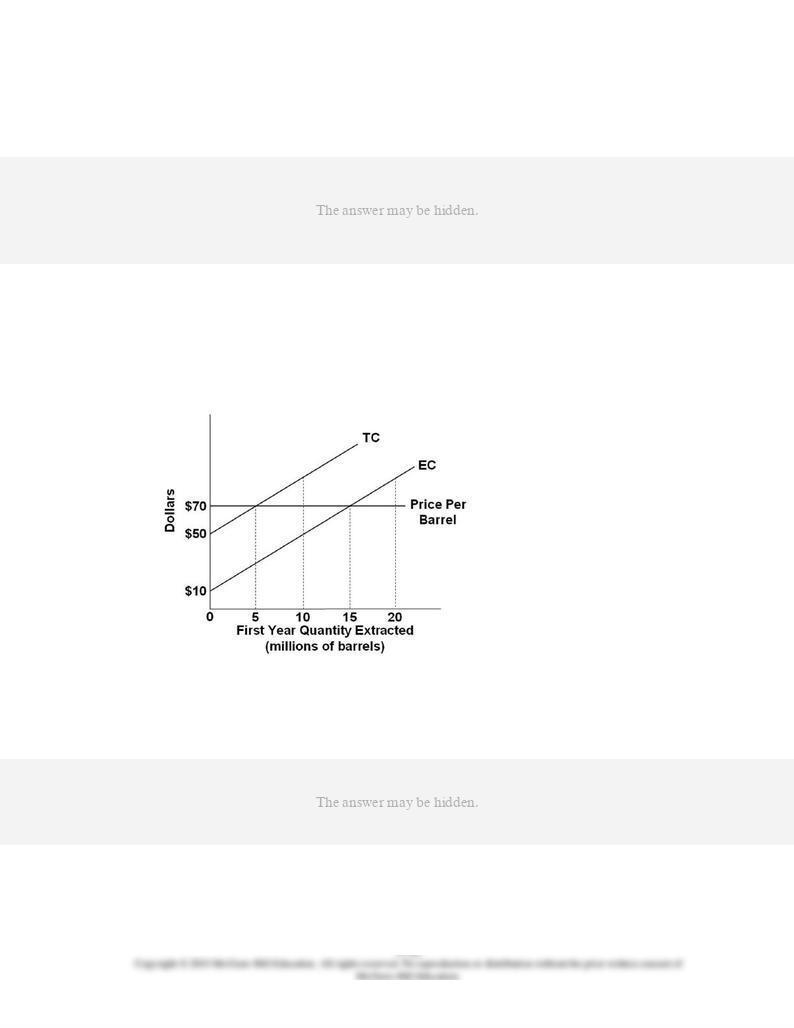
68.
A company's extraction cost curve slopes upward to reflect:
AACSB: Reflective Thinking
Accessibility: Keyboard Navigation
Blooms: Understand
Difficulty: 2 Medium
Learning Objective: 17-04 Show how the profit motive can encourage resource conservation.
Topic: Natural resource economics
69.
Refer to the diagram, representing Slippery Slope Oil Company. What is the user cost of
extracting a barrel of oil this year?
AACSB: Analytic
Blooms: Apply
Difficulty: 2 Medium

Learning Objective: 17-04 Show how the profit motive can encourage resource conservation.
Topic: Natural resource economics
Type: Graph
70.
Refer to the diagram, representing Slippery Slope Oil Company. How many million barrels
should Slippery Slope extract and sell this year?
A.
5.
B.
10.
C.
15.
AACSB: Analytic
Blooms: Analyze
Difficulty: 3 Hard
Learning Objective: 17-04 Show how the profit motive can encourage resource conservation.
Topic: Natural resource economics
Type: Graph
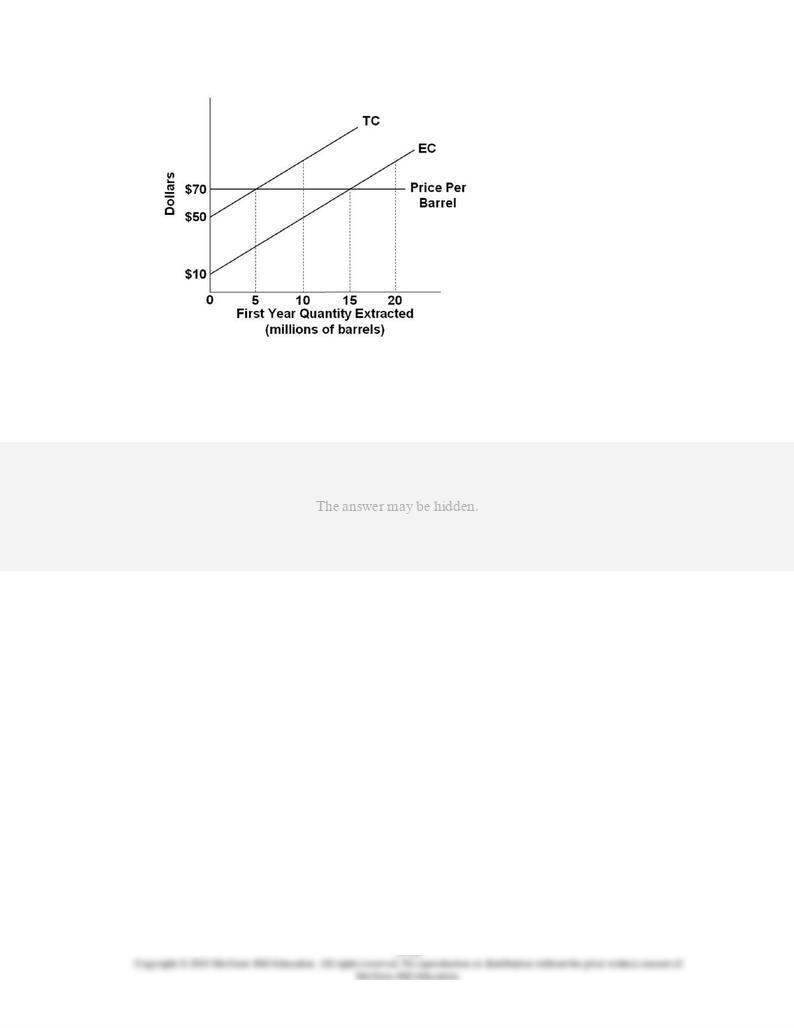
71.
Refer to the diagram, representing Slippery Slope Oil Company. A $10 increase in the user
cost would shift:
AACSB: Analytic
Blooms: Analyze
Difficulty: 3 Hard
Learning Objective: 17-04 Show how the profit motive can encourage resource conservation.
Topic: Natural resource economics
Type: Graph
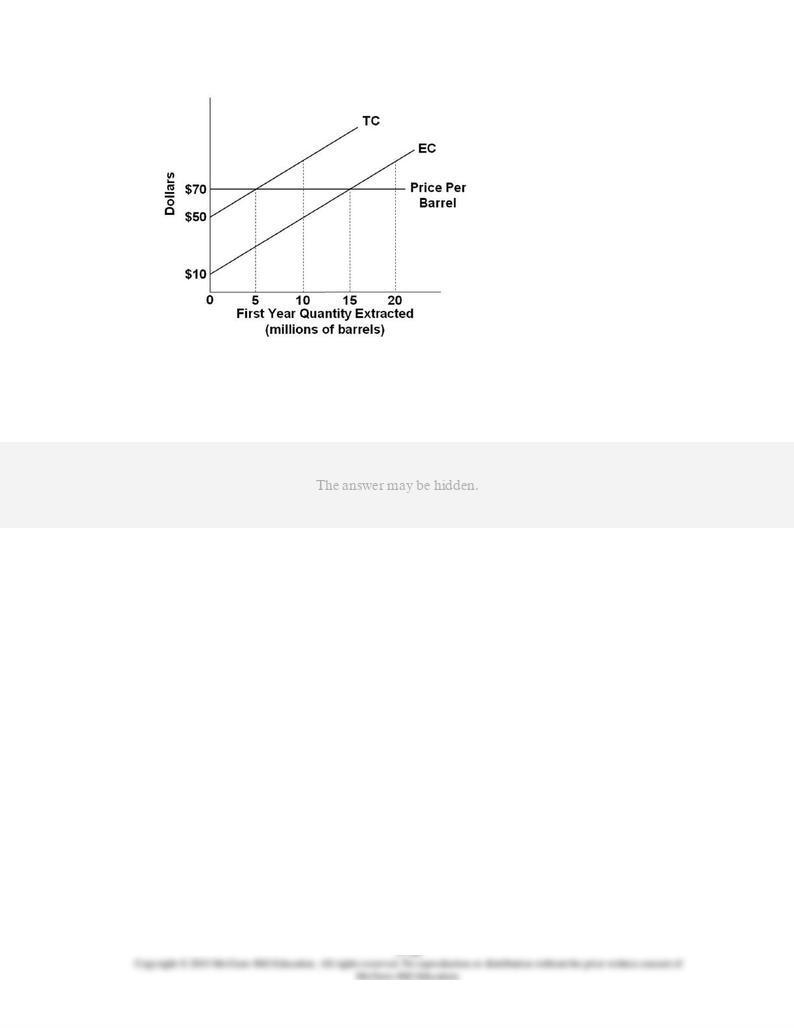
72.
Refer to the diagram, representing Slippery Slope Oil Company. A $5 decrease in the user
cost would:
AACSB: Analytic
Blooms: Analyze
Difficulty: 3 Hard
Learning Objective: 17-04 Show how the profit motive can encourage resource conservation.
Topic: Natural resource economics
Type: Graph
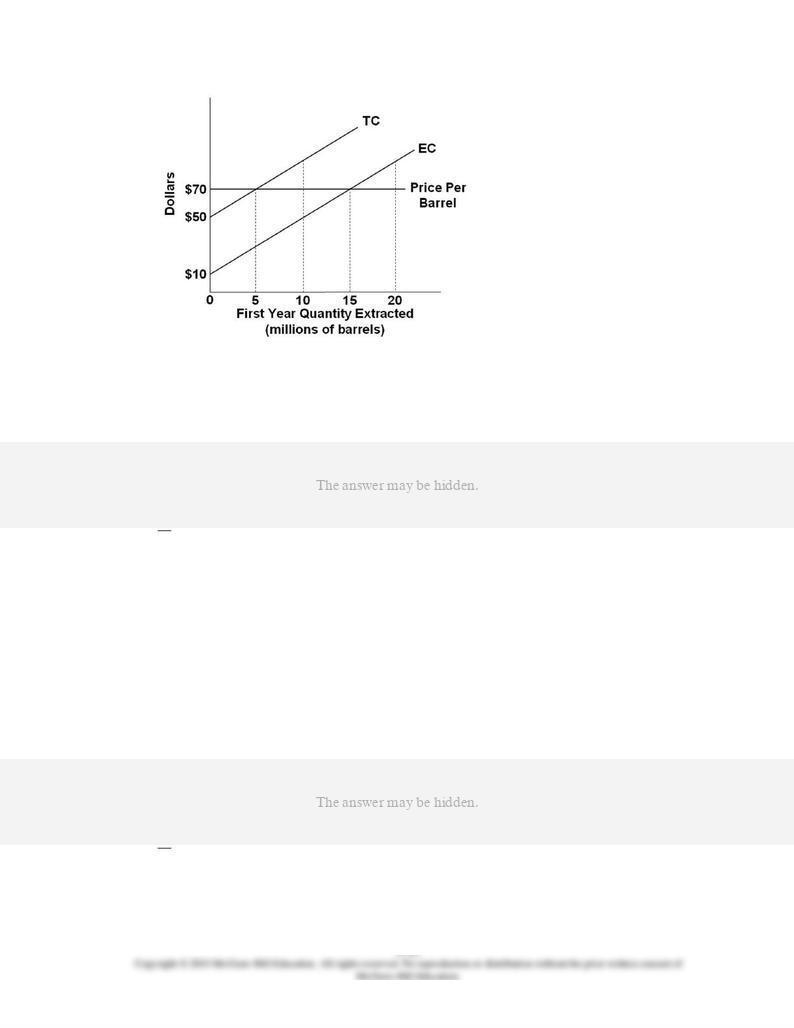
73.
Refer to the diagram, representing Slippery Slope Oil Company. What price of oil would
make 15 million barrels the optimal quantity to extract and sell this year?
AACSB: Analytic
Blooms: Analyze
Difficulty: 3 Hard
Learning Objective: 17-04 Show how the profit motive can encourage resource conservation.
Topic: Natural resource economics
Type: Graph
74.
Which of the following would cause the present optimal extraction level of a nonrenewable
resource to fall?
AACSB: Reflective Thinking
Accessibility: Keyboard Navigation
Blooms: Understand

Difficulty: 2 Medium
Learning Objective: 17-04 Show how the profit motive can encourage resource conservation.
Topic: Natural resource economics
75.
Which of the following would cause the present optimal extraction level of a nonrenewable
resource to rise?
AACSB: Reflective Thinking
Accessibility: Keyboard Navigation
Blooms: Understand
Difficulty: 2 Medium
Learning Objective: 17-04 Show how the profit motive can encourage resource conservation.
Topic: Natural resource economics
76.
Which of the following would cause the present optimal extraction level of a nonrenewable
resource to fall?
AACSB: Reflective Thinking
Accessibility: Keyboard Navigation
Blooms: Understand
Difficulty: 2 Medium
Learning Objective: 17-04 Show how the profit motive can encourage resource conservation.
Topic: Natural resource economics
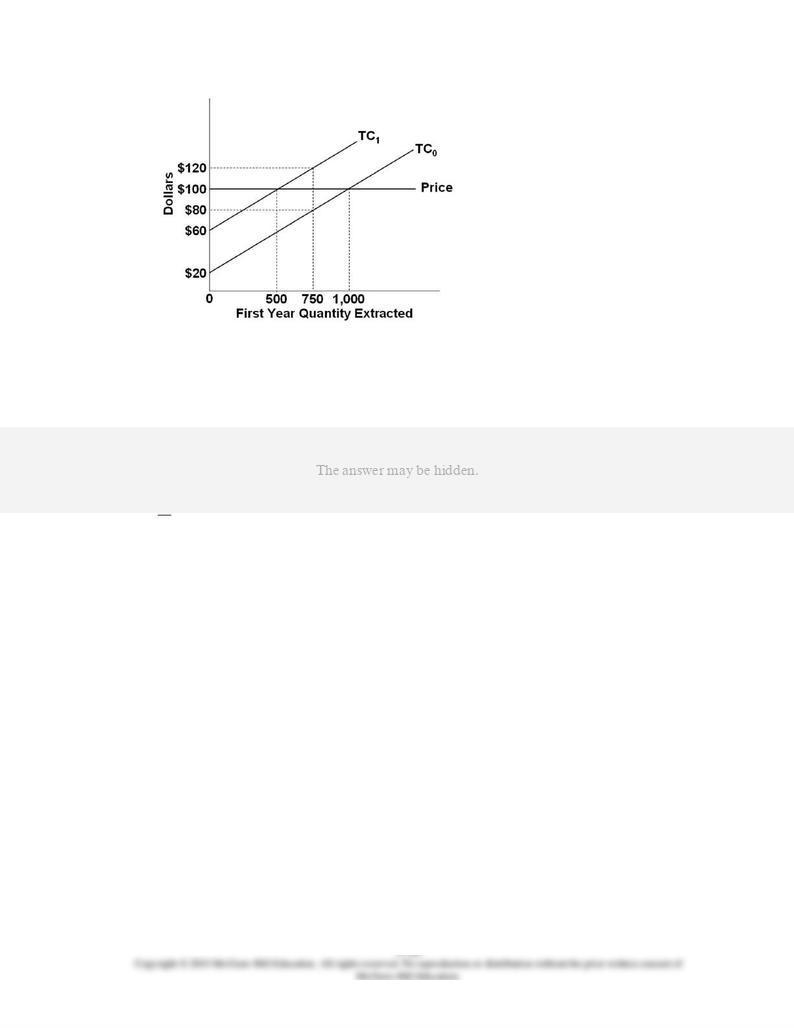
77.
Refer to the diagram, assuming that the firm represented is operating on curve TC0. What
is the user cost of extracting a unit of this resource?
AACSB: Analytic
Blooms: Apply
Difficulty: 2 Medium
Learning Objective: 17-04 Show how the profit motive can encourage resource conservation.
Topic: Natural resource economics
Type: Graph
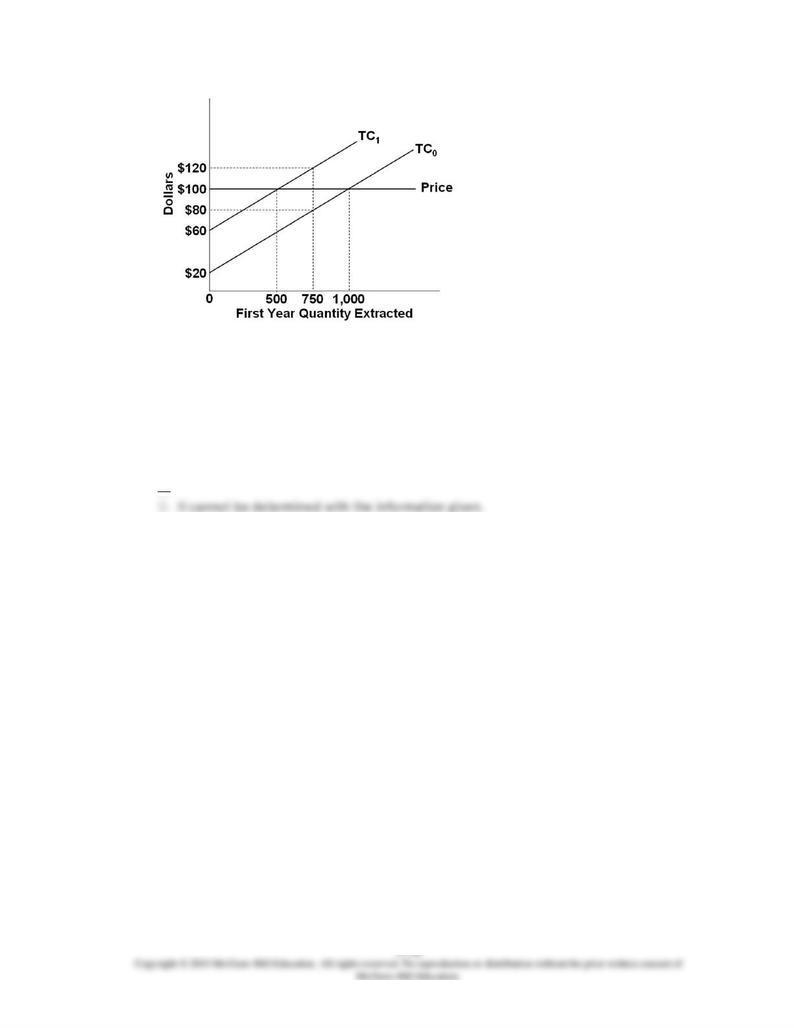
78.
Refer to the diagram, assuming that the firm represented is operating on curve TC0. How
much will the firm extract this year?
A.
500.
B.
750.
C.
1,000.
AACSB: Analytic
Blooms: Analyze
Difficulty: 3 Hard
Learning Objective: 17-04 Show how the profit motive can encourage resource conservation.
Topic: Natural resource economics
Type: Graph
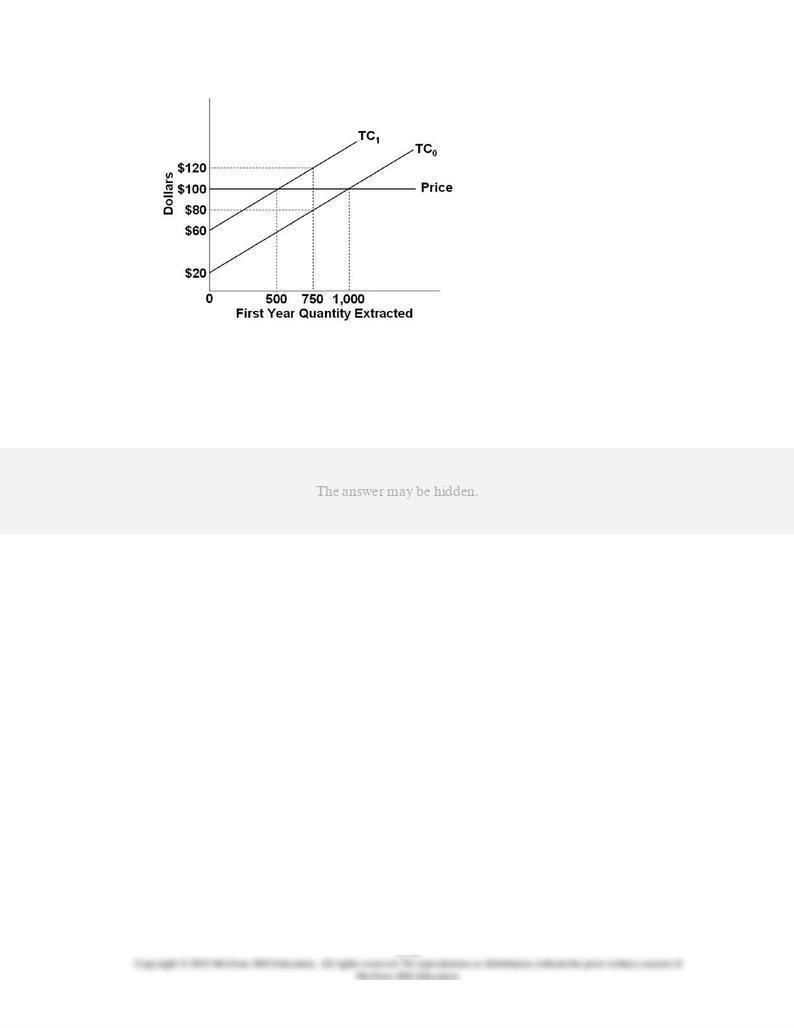
79.
Refer to the diagram, assuming that the firm represented is operating on curve TC0. If the
user cost increases by $20 at the beginning of the year, the quantity extracted in the first
year will:
AACSB: Analytic
Blooms: Analyze
Difficulty: 3 Hard
Learning Objective: 17-04 Show how the profit motive can encourage resource conservation.
Topic: Natural resource economics
Type: Graph
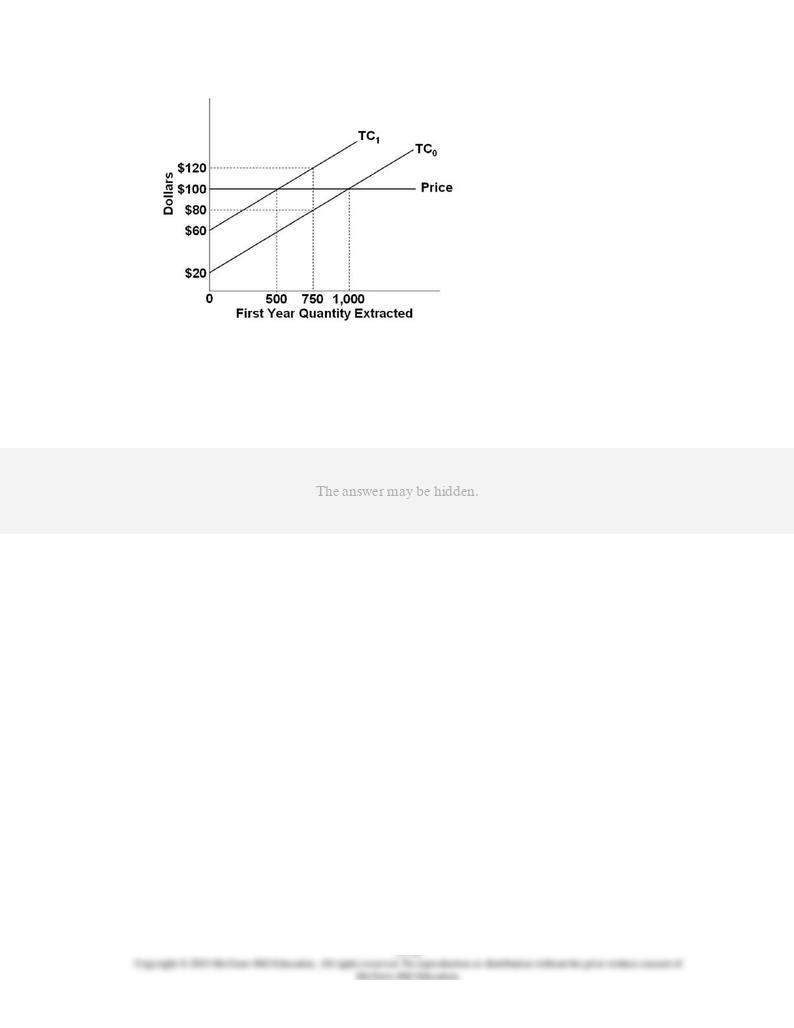
80.
Refer to the diagram, assuming that the firm represented is operating on curve TC1. If the
current price of the resource rises by $20, the optimal quantity extracted in the first year
will:
AACSB: Analytic
Blooms: Analyze
Difficulty: 3 Hard
Learning Objective: 17-04 Show how the profit motive can encourage resource conservation.
Topic: Natural resource economics
Type: Graph
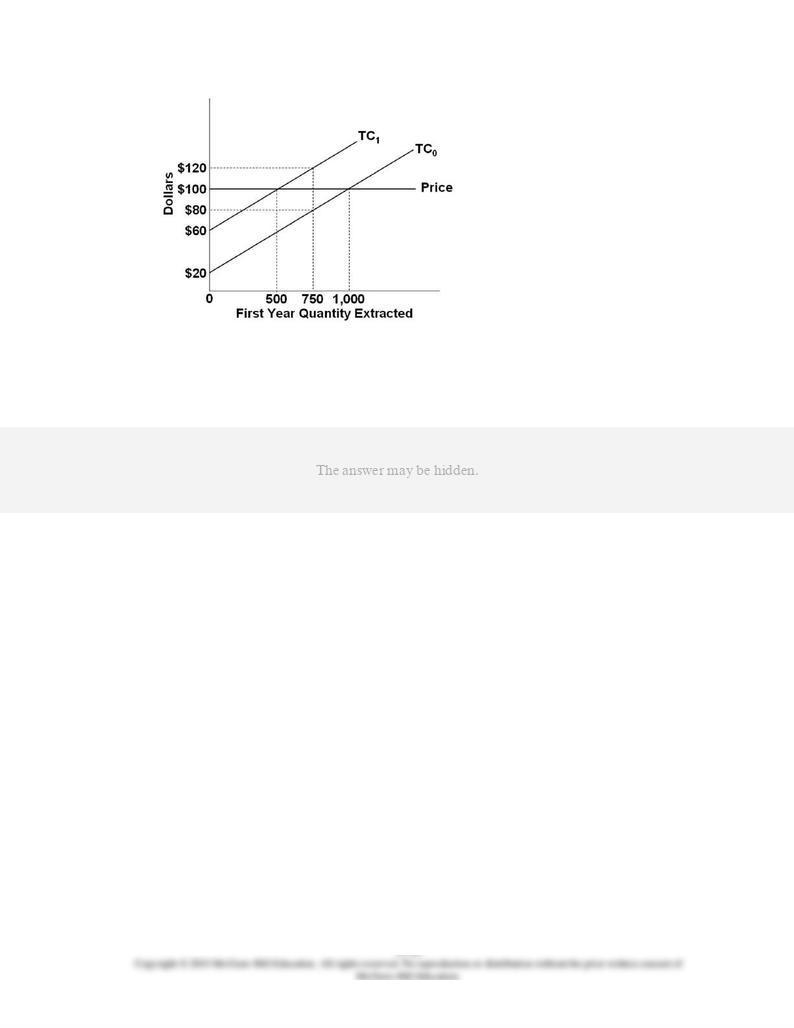
81.
Refer to the diagram, assuming that the firm represented is operating on curve TC0. A
change from TC0 to TC1 could be caused by:
AACSB: Reflective Thinking
Blooms: Apply
Difficulty: 2 Medium
Learning Objective: 17-04 Show how the profit motive can encourage resource conservation.
Topic: Natural resource economics
Type: Graph
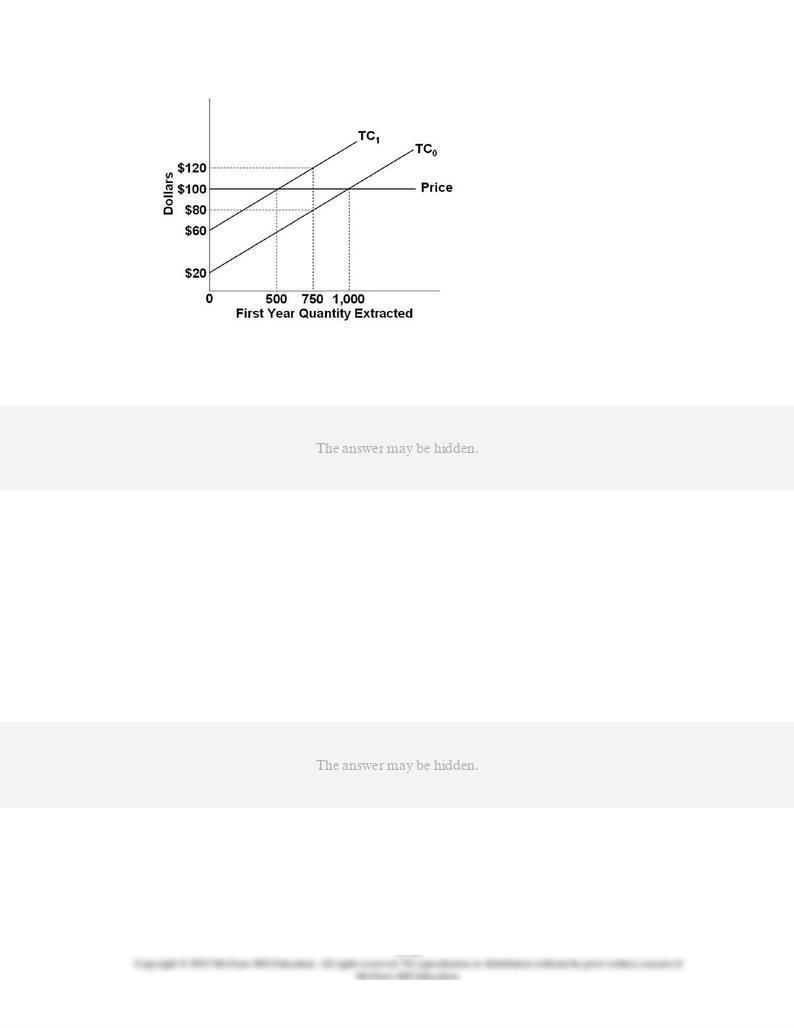
82.
Refer to the diagram. An increase in extraction costs could be shown by:
AACSB: Reflective Thinking
Blooms: Apply
Difficulty: 2 Medium
Learning Objective: 17-04 Show how the profit motive can encourage resource conservation.
Topic: Natural resource economics
Type: Graph
83.
An increase in the present value of the profit that can be obtained by delaying resource
extraction will lead profit-maximizing firms to:
AACSB: Reflective Thinking
Accessibility: Keyboard Navigation
Blooms: Analyze
Difficulty: 3 Hard
Learning Objective: 17-04 Show how the profit motive can encourage resource conservation.

Topic: Natural resource economics
84.
Profit-maximizing extraction companies will attempt to:
AACSB: Reflective Thinking
Accessibility: Keyboard Navigation
Blooms: Understand
Difficulty: 2 Medium
Learning Objective: 17-04 Show how the profit motive can encourage resource conservation.
Topic: Natural resource economics
85.
Which of the following is the best example of a market failure that would lead a firm to
extract resources at a rate that is faster than the rate that would maximize its long-term
stream of profits?
AACSB: Reflective Thinking
Accessibility: Keyboard Navigation
Blooms: Understand
Difficulty: 2 Medium
Learning Objective: 17-05 Relate how to use property rights to prevent deforestation and species extinction.
Topic: Renewable resources

86.
If property rights are weak or uncertain, resource extraction will tend to:
AACSB: Reflective Thinking
Accessibility: Keyboard Navigation
Blooms: Understand
Difficulty: 2 Medium
Learning Objective: 17-05 Relate how to use property rights to prevent deforestation and species extinction.
Topic: Renewable resources
87.
Mining of "conflict diamonds" tends to:
AACSB: Reflective Thinking
Accessibility: Keyboard Navigation
Blooms: Apply
Difficulty: 2 Medium
Learning Objective: 17-05 Relate how to use property rights to prevent deforestation and species extinction.
Topic: Renewable resources

88.
Elephant populations have:
AACSB: Reflective Thinking
Accessibility: Keyboard Navigation
Blooms: Apply
Difficulty: 2 Medium
Learning Objective: 17-05 Relate how to use property rights to prevent deforestation and species extinction.
Topic: Renewable resources
89.
In countries like Botswana and Zimbabwe, local villages have been given property rights
over local elephants with the result that elephant populations:
AACSB: Reflective Thinking
Accessibility: Keyboard Navigation
Blooms: Apply
Difficulty: 2 Medium
Learning Objective: 17-05 Relate how to use property rights to prevent deforestation and species extinction.
Topic: Renewable resources

90.
Renewable resources:
AACSB: Reflective Thinking
Accessibility: Keyboard Navigation
Blooms: Understand
Difficulty: 2 Medium
Learning Objective: 17-05 Relate how to use property rights to prevent deforestation and species extinction.
Topic: Renewable resources
91.
The amount of land covered by forests is:
A.
declining in all nations.
B.
increasing in all nations.
C.
increasing in places like the United States and Western Europe, while declining in
countries in South and Central America.
D.
declining in places like the United States and Western Europe, while increasing in
AACSB: Reflective Thinking
Accessibility: Keyboard Navigation
Blooms: Remember
Difficulty: 1 Easy
Learning Objective: 17-05 Relate how to use property rights to prevent deforestation and species extinction.
Topic: Renewable resources

92.
Some nations are increasing the amount of land covered by forests, while others are
experiencing rapid deforestation. According to economists, this is largely because:
AACSB: Reflective Thinking
Accessibility: Keyboard Navigation
Blooms: Remember
Difficulty: 1 Easy
Learning Objective: 17-05 Relate how to use property rights to prevent deforestation and species extinction.
Topic: Renewable resources
93.
Alex and Ben are both loggers wanting to harvest timber from the same forest. Alex
prefers to harvest and replant at a sustainable rate; Ben wants to harvest as many trees
as possible to maximize short-run profit, and then move on. They face the same
production costs.
Refer to the information given. If property rights are poorly enforced or nonexistent:
AACSB: Reflective Thinking
Accessibility: Keyboard Navigation
Blooms: Apply
Difficulty: 2 Medium
Learning Objective: 17-05 Relate how to use property rights to prevent deforestation and species extinction.
Topic: Renewable resources

94.
Alex and Ben are both loggers wanting to harvest timber from the same forest. Alex
prefers to harvest and replant at a sustainable rate; Ben wants to harvest as many trees
as possible to maximize short-run profit, and then move on. They face the same
production costs.
Refer to the information given. If property rights are well-defined and enforced:
AACSB: Reflective Thinking
Accessibility: Keyboard Navigation
Blooms: Apply
Difficulty: 2 Medium
Learning Objective: 17-05 Relate how to use property rights to prevent deforestation and species extinction.
Topic: Renewable resources
95.
Alex and Ben are both loggers wanting to harvest timber from the same forest. Alex
prefers to harvest and replant at a sustainable rate; Ben wants to harvest as many trees
as possible to maximize short-run profit, and then move on. They face the same
production costs.
Refer to the information given. The forest is more likely to be harvested and replanted at a
sustainable rate if:
AACSB: Reflective Thinking
Accessibility: Keyboard Navigation
Blooms: Apply
Difficulty: 2 Medium
Learning Objective: 17-05 Relate how to use property rights to prevent deforestation and species extinction.

Topic: Renewable resources
96.
Alex and Ben are both loggers wanting to harvest timber from the same forest. Alex
prefers to harvest and replant at a sustainable rate; Ben wants to harvest as many trees
as possible to maximize short-run profit, and then move on. They face the same
production costs.
Refer to the information given. If no explicit property right is given over the forest land,
then:
AACSB: Reflective Thinking
Accessibility: Keyboard Navigation
Blooms: Apply
Difficulty: 2 Medium
Learning Objective: 17-05 Relate how to use property rights to prevent deforestation and species extinction.
Topic: Renewable resources
97.
Which of the following best describes the typical growth pattern of trees for logging?
AACSB: Reflective Thinking
Accessibility: Keyboard Navigation
Blooms: Remember
Difficulty: 1 Easy
Learning Objective: 17-05 Relate how to use property rights to prevent deforestation and species extinction.
Topic: Renewable resources

98.
Forestry companies typically harvest and replant an area when trees are:
AACSB: Reflective Thinking
Accessibility: Keyboard Navigation
Blooms: Remember
Difficulty: 1 Easy
Learning Objective: 17-05 Relate how to use property rights to prevent deforestation and species extinction.
Topic: Renewable resources
99.
In fisheries management, a
fishery
is defined as:
AACSB: Analytic
Accessibility: Keyboard Navigation
Blooms: Remember
Difficulty: 1 Easy
Learning Objective: 17-05 Relate how to use property rights to prevent deforestation and species extinction.
Topic: Renewable resources
100.
Which of the following is the best example of a fishery?
AACSB: Reflective Thinking

Accessibility: Keyboard Navigation
Blooms: Apply
Difficulty: 2 Medium
Learning Objective: 17-05 Relate how to use property rights to prevent deforestation and species extinction.
Topic: Renewable resources
101.
What was the largest U.S. fishery, in dollar terms, in 2010?
AACSB: Reflective Thinking
Accessibility: Keyboard Navigation
Blooms: Remember
Difficulty: 1 Easy
Learning Objective: 17-05 Relate how to use property rights to prevent deforestation and species extinction.
Topic: Renewable resources
102.
A fishery is typically identified by:
AACSB: Analytic
Accessibility: Keyboard Navigation
Blooms: Remember
Difficulty: 1 Easy
Learning Objective: 17-05 Relate how to use property rights to prevent deforestation and species extinction.
Topic: Renewable resources

103.
It is generally easier to prevent deforestation than fishery collapse because:
AACSB: Reflective Thinking
Accessibility: Keyboard Navigation
Blooms: Understand
Difficulty: 2 Medium
Learning Objective: 17-05 Relate how to use property rights to prevent deforestation and species extinction.
Topic: Renewable resources
104.
Property rights for fish from the open ocean:
AACSB: Reflective Thinking
Accessibility: Keyboard Navigation
Blooms: Understand
Difficulty: 2 Medium
Learning Objective: 17-05 Relate how to use property rights to prevent deforestation and species extinction.
Topic: Renewable resources
105.
A fishery collapse:
AACSB: Reflective Thinking

Accessibility: Keyboard Navigation
Blooms: Understand
Difficulty: 2 Medium
Learning Objective: 17-05 Relate how to use property rights to prevent deforestation and species extinction.
Topic: Renewable resources
106.
Which of the following policies has succeeded in reducing fishery catch sizes?
A.
Limiting the length of the catch season.
AACSB: Reflective Thinking
Accessibility: Keyboard Navigation
Blooms: Remember
Difficulty: 1 Easy
Learning Objective: 17-05 Relate how to use property rights to prevent deforestation and species extinction.
Topic: Renewable resources
107.
Which of the following policies has succeeded in reducing fishery catch sizes
without
creating an "arms race" among fishers?
A.
Limiting the length of the catch season.
AACSB: Reflective Thinking
Accessibility: Keyboard Navigation
Blooms: Remember
Difficulty: 1 Easy
Learning Objective: 17-05 Relate how to use property rights to prevent deforestation and species extinction.
Topic: Renewable resources

108.
Total allowable catch (TAC):
A.
explicitly limits the number of days in a season that particular fish may be caught.
AACSB: Analytic
Accessibility: Keyboard Navigation
Blooms: Remember
Difficulty: 1 Easy
Learning Objective: 17-05 Relate how to use property rights to prevent deforestation and species extinction.
Topic: Renewable resources
109.
In fisheries management,
ITQ
stands for:
A.
international transferable quota.
AACSB: Analytic
Accessibility: Keyboard Navigation
Blooms: Remember
Difficulty: 1 Easy
Learning Objective: 17-05 Relate how to use property rights to prevent deforestation and species extinction.
Topic: Renewable resources
110.
Under a TAC system, fishing of a particular fishery is halted after:
AACSB: Reflective Thinking
Accessibility: Keyboard Navigation
Blooms: Understand

Difficulty: 2 Medium
Learning Objective: 17-05 Relate how to use property rights to prevent deforestation and species extinction.
Topic: Renewable resources
111.
Kara and Kyle are competing sockeye salmon fishers. Both have been allocated ITQs that
limit their catch to 2,000 tons of sockeye salmon each. Kara's cost per ton is $8; Kyle's
cost per ton is $12.
Refer to the information given. If the market price of sockeye salmon is $15 per ton, and
Kara and Kyle both catch their quota, their combined profit will be:
AACSB: Analytic
Accessibility: Keyboard Navigation
Blooms: Apply
Difficulty: 2 Medium
Learning Objective: 17-05 Relate how to use property rights to prevent deforestation and species extinction.
Topic: Renewable resources
112.
Kara and Kyle are competing sockeye salmon fishers. Both have been allocated ITQs that
limit their catch to 2,000 tons of sockeye salmon each. Kara's cost per ton is $8; Kyle's
cost per ton is $12.
Refer to the information given. If the market price of sockeye salmon is $15 per ton, what
is the maximum amount Kara would be willing to pay per ton for Kyle's ITQs?
AACSB: Analytic
Accessibility: Keyboard Navigation
Blooms: Apply
Difficulty: 2 Medium
Learning Objective: 17-05 Relate how to use property rights to prevent deforestation and species extinction.

Topic: Renewable resources
113.
Kara and Kyle are competing sockeye salmon fishers. Both have been allocated ITQs that
limit their catch to 2,000 tons of sockeye salmon each. Kara's cost per ton is $8; Kyle's
cost per ton is $12.
Refer to the information given and assume that the market price of sockeye salmon is $15
per ton. If Kara pays Kyle $5 per ton for his ITQs, and if she then catches her new limit of
4,000 tons, their combined profit would be:
AACSB: Analytic
Accessibility: Keyboard Navigation
Blooms: Apply
Difficulty: 2 Medium
Learning Objective: 17-05 Relate how to use property rights to prevent deforestation and species extinction.
Topic: Renewable resources
114.
Kara and Kyle are competing sockeye salmon fishers. Both have been allocated ITQs that
limit their catch to 2,000 tons of sockeye salmon each. Kara's cost per ton is $8; Kyle's
cost per ton is $12.
Refer to the information given. If the market price of sockeye salmon is $15 per ton, what
is the minimum amount per ton that Kara would have to offer Kyle to convince him to sell
Kara his ITQs?
AACSB: Analytic
Accessibility: Keyboard Navigation
Blooms: Apply
Difficulty: 2 Medium
Learning Objective: 17-05 Relate how to use property rights to prevent deforestation and species extinction.

Topic: Renewable resources
115.
Melanie and Oli are competing Pacific halibut fishers. Both have been allocated ITQs that
limit their catch to 1,000 tons of Pacific halibut each. Melanie's cost per ton is $20; Oli's
cost per ton is $28.
Refer to the information given. If the market price of Pacific halibut is $40 per ton, and
Melanie and Oli both catch their quota, their combined profit will be:
AACSB: Analytic
Accessibility: Keyboard Navigation
Blooms: Apply
Difficulty: 2 Medium
Learning Objective: 17-05 Relate how to use property rights to prevent deforestation and species extinction.
Topic: Renewable resources
116.
Melanie and Oli are competing Pacific halibut fishers. Both have been allocated ITQs that
limit their catch to 1,000 tons of Pacific halibut each. Melanie's cost per ton is $20; Oli's
cost per ton is $28.
Refer to the information given. If the market price of Pacific halibut is $40 per ton, what is
the maximum amount Melanie would be willing to pay per ton for Oli's ITQs?
AACSB: Analytic
Accessibility: Keyboard Navigation
Blooms: Apply
Difficulty: 2 Medium
Learning Objective: 17-05 Relate how to use property rights to prevent deforestation and species extinction.
Topic: Renewable resources

117.
Melanie and Oli are competing Pacific halibut fishers. Both have been allocated ITQs that
limit their catch to 1,000 tons of Pacific halibut each. Melanie's cost per ton is $20; Oli's
cost per ton is $28.
Refer to the information given and assume that the market price of Pacific halibut is $40
per ton. If Melanie pays Oli $10 per ton for his ITQs and then catches her new limit of
2,000 tons, their combined profit would be:
AACSB: Analytic
Accessibility: Keyboard Navigation
Blooms: Apply
Difficulty: 2 Medium
Learning Objective: 17-05 Relate how to use property rights to prevent deforestation and species extinction.
Topic: Renewable resources
118.
Melanie and Oli are competing Pacific halibut fishers. Both have been allocated ITQs that
limit their catch to 1,000 tons of Pacific halibut each. Melanie's cost per ton is $20; Oli's
cost per ton is $28.
Refer to the information given. If the market price of Pacific halibut is $40 per ton, what is
the minimum amount per ton that Melanie would have to offer Oli to convince him to sell
Melanie his ITQs?
AACSB: Analytic
Accessibility: Keyboard Navigation
Blooms: Apply
Difficulty: 2 Medium
Learning Objective: 17-05 Relate how to use property rights to prevent deforestation and species extinction.
Topic: Renewable resources

119.
Individual transferable quotas (ITQs):
AACSB: Reflective Thinking
Accessibility: Keyboard Navigation
Blooms: Understand
Difficulty: 2 Medium
Learning Objective: 17-05 Relate how to use property rights to prevent deforestation and species extinction.
Topic: Renewable resources
120.
Total allowable catch policies and individual transferable quotas both:
AACSB: Reflective Thinking
Accessibility: Keyboard Navigation
Blooms: Understand
Difficulty: 2 Medium
Learning Objective: 17-05 Relate how to use property rights to prevent deforestation and species extinction.
Topic: Renewable resources
121.
Individual transferable quotas are limited in their effectiveness because:
AACSB: Reflective Thinking
Accessibility: Keyboard Navigation
Blooms: Remember
Difficulty: 1 Easy

Learning Objective: 17-05 Relate how to use property rights to prevent deforestation and species extinction.
Topic: Renewable resources
122.
(Consider This) Governments' main economic concern about low birthrates is that:
AACSB: Reflective Thinking
Accessibility: Keyboard Navigation
Blooms: Apply
Difficulty: 2 Medium
Learning Objective: 17-01 Explain why falling birthrates mean that we are not likely to run out of natural resources.
Topic: Resource supplies: doom or boom?
123.
(Consider This) Which of the following nations has implemented policies that pay women
to have additional children?
AACSB: Reflective Thinking
Accessibility: Keyboard Navigation
Blooms: Apply
Difficulty: 2 Medium
Learning Objective: 17-01 Explain why falling birthrates mean that we are not likely to run out of natural resources.
Topic: Resource supplies: doom or boom?

124.
(Consider This) Which of the following nations has implemented policies that pay women
to have additional children?
A.
Italy.
B.
United States.
AACSB: Reflective Thinking
Accessibility: Keyboard Navigation
Blooms: Apply
Difficulty: 2 Medium
Learning Objective: 17-01 Explain why falling birthrates mean that we are not likely to run out of natural resources.
Topic: Resource supplies: doom or boom?
125.
(Consider This) Which of the following best explains why the solar panel companies
Solyndra and Abound went bankrupt in 2011 and 2012, respectively?
AACSB: Reflective Thinking
Accessibility: Keyboard Navigation
Blooms: Understand
Difficulty: 2 Medium
Learning Objective: 17-03 Discuss why running out of oil would not mean running out of energy.
Topic: Running out of energy?

126.
(Consider This) According to the International Energy Agency:
2030.
C.
the world will economically exhaust its oil and natural gas deposits by 2025.
D.
government subsidies have hindered the development of alternative energy.
AACSB: Reflective Thinking
Accessibility: Keyboard Navigation
Blooms: Remember
Difficulty: 1 Easy
Learning Objective: 17-03 Discuss why running out of oil would not mean running out of energy.
Topic: Running out of energy?
127.
(Consider This) The tragedy of the commons occurs primarily:
AACSB: Reflective Thinking
Accessibility: Keyboard Navigation
Blooms: Remember
Difficulty: 1 Easy
Learning Objective: 17-05 Relate how to use property rights to prevent deforestation and species extinction.
Topic: Renewable resources

128.
(Consider This) Garrett Hardin's tragedy of the commons best applies to which of the
following issues?
AACSB: Reflective Thinking
Accessibility: Keyboard Navigation
Blooms: Understand
Difficulty: 2 Medium
Learning Objective: 17-05 Relate how to use property rights to prevent deforestation and species extinction.
Topic: Renewable resources
129.
(Last Word) Most economists view economic growth as:
AACSB: Reflective Thinking
Accessibility: Keyboard Navigation
Blooms: Remember
Difficulty: 1 Easy
Learning Objective: 17-01 Explain why falling birthrates mean that we are not likely to run out of natural resources.
Learning Objective: 17-05 Relate how to use property rights to prevent deforestation and species extinction.
Topic: Renewable resources
Topic: Resource supplies: doom or boom?

130.
(Last Word) According to Yale University's Environmental Performance Index (EPI):
AACSB: Reflective Thinking
Accessibility: Keyboard Navigation
Blooms: Remember
Difficulty: 1 Easy
Learning Objective: 17-01 Explain why falling birthrates mean that we are not likely to run out of natural resources.
Learning Objective: 17-05 Relate how to use property rights to prevent deforestation and species extinction.
Topic: Renewable resources
Topic: Resource supplies: doom or boom?
131.
(Last Word) In 2012, the countries with the highest scores on the Environmental
Performance Index were:
A.
the United States and Tanzania.
B.
Switzerland and Latvia.
C.
New Zealand and Sweden.
AACSB: Reflective Thinking
Accessibility: Keyboard Navigation
Blooms: Remember
Difficulty: 1 Easy
Learning Objective: 17-01 Explain why falling birthrates mean that we are not likely to run out of natural resources.
Learning Objective: 17-05 Relate how to use property rights to prevent deforestation and species extinction.
Topic: Renewable resources
Topic: Resource supplies: doom or boom?
True / False Questions

132.
Human beings consume more both in absolute terms and on a per capita basis than they
did 200 years ago.
AACSB: Reflective Thinking
Accessibility: Keyboard Navigation
Blooms: Remember
Difficulty: 1 Easy
Learning Objective: 17-01 Explain why falling birthrates mean that we are not likely to run out of natural resources.
Topic: Resource supplies: doom or boom?
133.
Thomas Malthus argued that increases in living standards tend to reduce birthrates.
AACSB: Reflective Thinking
Accessibility: Keyboard Navigation
Blooms: Remember
Difficulty: 1 Easy
Learning Objective: 17-01 Explain why falling birthrates mean that we are not likely to run out of natural resources.
Topic: Resource supplies: doom or boom?
134.
A total fertility rate of 1.0 is necessary to keep the population constant over time.
AACSB: Reflective Thinking
Accessibility: Keyboard Navigation
Blooms: Remember
Difficulty: 1 Easy
Learning Objective: 17-01 Explain why falling birthrates mean that we are not likely to run out of natural resources.
Topic: Resource supplies: doom or boom?
135.
Most developed countries have fertility rates less than 2.1.
AACSB: Reflective Thinking
Accessibility: Keyboard Navigation
Blooms: Remember
Difficulty: 1 Easy
Learning Objective: 17-01 Explain why falling birthrates mean that we are not likely to run out of natural resources.
Topic: Resource supplies: doom or boom?

136.
A total fertility rate of approximately 1.0 will cause each generation to be half as large as
the preceding generation.
AACSB: Reflective Thinking
Accessibility: Keyboard Navigation
Blooms: Understand
Difficulty: 2 Medium
Learning Objective: 17-01 Explain why falling birthrates mean that we are not likely to run out of natural resources.
Topic: Resource supplies: doom or boom?
137.
Modernizing economies that have declining birthrates may still experience population
growth because of rapidly declining death rates.
AACSB: Reflective Thinking
Accessibility: Keyboard Navigation
Blooms: Understand
Difficulty: 2 Medium
Learning Objective: 17-01 Explain why falling birthrates mean that we are not likely to run out of natural resources.
Topic: Resource supplies: doom or boom?
138.
The demand for productive resources has grown faster than the supply of productive
resources for the past 150 years.
AACSB: Reflective Thinking
Accessibility: Keyboard Navigation
Blooms: Remember
Difficulty: 1 Easy
Learning Objective: 17-01 Explain why falling birthrates mean that we are not likely to run out of natural resources.
Topic: Resource supplies: doom or boom?
139.
The
Economist
's Commodity Price Index reveals that the supply of productive resources
has increased faster than the demand for decades.
AACSB: Reflective Thinking

Accessibility: Keyboard Navigation
Blooms: Remember
Difficulty: 1 Easy
Learning Objective: 17-01 Explain why falling birthrates mean that we are not likely to run out of natural resources.
Topic: Resource supplies: doom or boom?
140.
Demographers expect world population to ultimately decline in the next century.
AACSB: Reflective Thinking
Accessibility: Keyboard Navigation
Blooms: Remember
Difficulty: 1 Easy
Learning Objective: 17-01 Explain why falling birthrates mean that we are not likely to run out of natural resources.
Topic: Resource supplies: doom or boom?
141.
Commodity prices are relatively stable from year to year.
AACSB: Reflective Thinking
Accessibility: Keyboard Navigation
Blooms: Remember
Difficulty: 1 Easy
Learning Objective: 17-01 Explain why falling birthrates mean that we are not likely to run out of natural resources.
Topic: Resource supplies: doom or boom?
142.
Per capita water use in the United States has steadily increased since 1973.
AACSB: Reflective Thinking
Accessibility: Keyboard Navigation
Blooms: Remember
Difficulty: 1 Easy
Learning Objective: 17-01 Explain why falling birthrates mean that we are not likely to run out of natural resources.
Topic: Resource supplies: doom or boom?
143.
Per capita energy use in the United States has remained fairly constant since 1980.
AACSB: Reflective Thinking

Accessibility: Keyboard Navigation
Blooms: Remember
Difficulty: 1 Easy
Learning Objective: 17-01 Explain why falling birthrates mean that we are not likely to run out of natural resources.
Learning Objective: 17-02 Describe why using a mix of energy sources is efficient; even if some of them are quite costly.
Topic: Energy economics
Topic: Resource supplies: doom or boom?
144.
A British thermal unit is the amount of energy required to raise the temperature of one
liter of water by one degree Celsius.
AACSB: Analytic
Accessibility: Keyboard Navigation
Blooms: Remember
Difficulty: 1 Easy
Learning Objective: 17-02 Describe why using a mix of energy sources is efficient; even if some of them are quite costly.
Topic: Energy economics
145.
The average person in the United States generates about 10 pounds of trash per day.
AACSB: Reflective Thinking
Accessibility: Keyboard Navigation
Blooms: Remember
Difficulty: 1 Easy
Learning Objective: 17-01 Explain why falling birthrates mean that we are not likely to run out of natural resources.
Topic: Resource supplies: doom or boom?
146.
The United States produces more than twice as much output per million BTUs of energy
consumed than it did in 1950.
AACSB: Reflective Thinking
Accessibility: Keyboard Navigation
Blooms: Remember
Difficulty: 1 Easy
Learning Objective: 17-01 Explain why falling birthrates mean that we are not likely to run out of natural resources.
Learning Objective: 17-02 Describe why using a mix of energy sources is efficient; even if some of them are quite costly.
Topic: Energy economics
Topic: Resource supplies: doom or boom?

147.
Increases in U.S. living standards have matched increases in per capita energy use.
AACSB: Reflective Thinking
Accessibility: Keyboard Navigation
Blooms: Remember
Difficulty: 1 Easy
Learning Objective: 17-01 Explain why falling birthrates mean that we are not likely to run out of natural resources.
Learning Objective: 17-02 Describe why using a mix of energy sources is efficient; even if some of them are quite costly.
Topic: Energy economics
Topic: Resource supplies: doom or boom?
148.
Energy demand is relatively stable over the course of a day.
AACSB: Reflective Thinking
Accessibility: Keyboard Navigation
Blooms: Remember
Difficulty: 1 Easy
Learning Objective: 17-02 Describe why using a mix of energy sources is efficient; even if some of them are quite costly.
Topic: Energy economics
149.
Electricity generating plants with low fixed costs tend to have high operating costs.
AACSB: Reflective Thinking
Accessibility: Keyboard Navigation
Blooms: Remember
Difficulty: 1 Easy
Learning Objective: 17-02 Describe why using a mix of energy sources is efficient; even if some of them are quite costly.
Topic: Energy economics
150.
In electricity generation, it is most economically efficient to use a single energy source.
AACSB: Reflective Thinking
Accessibility: Keyboard Navigation
Blooms: Remember
Difficulty: 1 Easy
Learning Objective: 17-02 Describe why using a mix of energy sources is efficient; even if some of them are quite costly.

Topic: Energy economics
151.
About two-thirds of U.S. electricity is generated at coal and gas plants.
AACSB: Reflective Thinking
Accessibility: Keyboard Navigation
Blooms: Remember
Difficulty: 1 Easy
Learning Objective: 17-02 Describe why using a mix of energy sources is efficient; even if some of them are quite costly.
Topic: Energy economics
152.
About one-half of U.S. electricity is generated using petroleum.
AACSB: Reflective Thinking
Accessibility: Keyboard Navigation
Blooms: Remember
Difficulty: 1 Easy
Learning Objective: 17-02 Describe why using a mix of energy sources is efficient; even if some of them are quite costly.
Topic: Energy economics
153.
Renewable energy sources account for about 50 percent of U.S. electricity generation.
AACSB: Reflective Thinking
Accessibility: Keyboard Navigation
Blooms: Remember
Difficulty: 1 Easy
Learning Objective: 17-02 Describe why using a mix of energy sources is efficient; even if some of them are quite costly.
Topic: Energy economics
154.
The United States is in imminent danger of running out of energy.
AACSB: Reflective Thinking
Accessibility: Keyboard Navigation
Blooms: Remember
Difficulty: 1 Easy
Learning Objective: 17-03 Discuss why running out of oil would not mean running out of energy.

Topic: Running out of energy?
155.
Renewable natural resources can never be exhausted.
AACSB: Reflective Thinking
Accessibility: Keyboard Navigation
Blooms: Understand
Difficulty: 2 Medium
Learning Objective: 17-03 Discuss why running out of oil would not mean running out of energy.
Topic: Running out of energy?
156.
Nonrenewable natural resources are fixed in supply (actually or virtually).
AACSB: Analytic
Accessibility: Keyboard Navigation
Blooms: Remember
Difficulty: 1 Easy
Learning Objective: 17-03 Discuss why running out of oil would not mean running out of energy.
Learning Objective: 17-04 Show how the profit motive can encourage resource conservation.
Topic: Natural resource economics
Topic: Running out of energy?
157.
Assuming that interest rates are positive, the present value of an $80 barrel of oil in two
years is less than an $80 barrel today.
AACSB: Analytic
Accessibility: Keyboard Navigation
Blooms: Understand
Difficulty: 2 Medium
Learning Objective: 17-04 Show how the profit motive can encourage resource conservation.
Topic: Natural resource economics
158.
Present value allows us to weigh the benefits and costs of using resources today or in the
future.
AACSB: Reflective Thinking

Accessibility: Keyboard Navigation
Blooms: Remember
Difficulty: 1 Easy
Learning Objective: 17-04 Show how the profit motive can encourage resource conservation.
Topic: Natural resource economics
159.
The user cost of a resource is the market price paid by the buyer of the resource.
AACSB: Analytic
Accessibility: Keyboard Navigation
Blooms: Remember
Difficulty: 1 Easy
Learning Objective: 17-04 Show how the profit motive can encourage resource conservation.
Topic: Natural resource economics
160.
Higher user costs imply that a resource should be extracted more quickly.
AACSB: Reflective Thinking
Accessibility: Keyboard Navigation
Blooms: Understand
Difficulty: 2 Medium
Learning Objective: 17-04 Show how the profit motive can encourage resource conservation.
Topic: Natural resource economics
161.
The total cost of extracting and selling a resource in a given year is the sum of the
extraction cost and user cost.
AACSB: Analytic
Accessibility: Keyboard Navigation
Blooms: Remember
Difficulty: 1 Easy
Learning Objective: 17-04 Show how the profit motive can encourage resource conservation.
Topic: Natural resource economics

162.
The higher a resource's current price, the more extraction should be delayed to a later
period.
AACSB: Reflective Thinking
Accessibility: Keyboard Navigation
Blooms: Understand
Difficulty: 2 Medium
Learning Objective: 17-04 Show how the profit motive can encourage resource conservation.
Topic: Natural resource economics
163.
User cost is defined as the present value of the profit the company would earn if it delayed
extraction until next year.
AACSB: Analytic
Accessibility: Keyboard Navigation
Blooms: Remember
Difficulty: 1 Easy
Learning Objective: 17-04 Show how the profit motive can encourage resource conservation.
Topic: Natural resource economics
164.
Weak property rights encourage faster extraction than would otherwise maximize the long-
term stream of profits.
AACSB: Reflective Thinking
Accessibility: Keyboard Navigation
Blooms: Understand
Difficulty: 2 Medium
Learning Objective: 17-04 Show how the profit motive can encourage resource conservation.
Learning Objective: 17-05 Relate how to use property rights to prevent deforestation and species extinction.
Topic: Natural resource economics
Topic: Renewable resources

165.
Elephants are moving closer to extinction in places where they are treated as private
property.
AACSB: Reflective Thinking
Accessibility: Keyboard Navigation
Blooms: Apply
Difficulty: 2 Medium
Learning Objective: 17-04 Show how the profit motive can encourage resource conservation.
Learning Objective: 17-05 Relate how to use property rights to prevent deforestation and species extinction.
Topic: Natural resource economics
Topic: Renewable resources
166.
The economic benefits of forests include provision of wildlife habitats, erosion prevention,
and oxygen production.
AACSB: Reflective Thinking
Accessibility: Keyboard Navigation
Blooms: Remember
Difficulty: 1 Easy
Learning Objective: 17-05 Relate how to use property rights to prevent deforestation and species extinction.
Topic: Renewable resources
167.
In the United States and parts of Western Europe, the amount of land covered by forests is
increasing.
AACSB: Reflective Thinking
Accessibility: Keyboard Navigation
Blooms: Remember
Difficulty: 1 Easy
Learning Objective: 17-05 Relate how to use property rights to prevent deforestation and species extinction.
Topic: Renewable resources

168.
In the absence of enforceable property rights, there is little incentive to preserve resources
for future use.
AACSB: Reflective Thinking
Accessibility: Keyboard Navigation
Blooms: Understand
Difficulty: 2 Medium
Learning Objective: 17-05 Relate how to use property rights to prevent deforestation and species extinction.
Topic: Renewable resources
169.
Granting property rights to forest land tends to increase the rate at which the land is
deforested.
AACSB: Reflective Thinking
Accessibility: Keyboard Navigation
Blooms: Apply
Difficulty: 2 Medium
Learning Objective: 17-05 Relate how to use property rights to prevent deforestation and species extinction.
Topic: Renewable resources
170.
A
fishery
is a stock of fish or other marine animal thought of as a logically distinct group,
and usually identified by its location and species.
AACSB: Analytic
Accessibility: Keyboard Navigation
Blooms: Remember
Difficulty: 1 Easy
Learning Objective: 17-05 Relate how to use property rights to prevent deforestation and species extinction.
Topic: Renewable resources
171.
Fish in the open ocean are protected by strong property rights.
AACSB: Reflective Thinking
Accessibility: Keyboard Navigation
Blooms: Apply

Difficulty: 2 Medium
Learning Objective: 17-05 Relate how to use property rights to prevent deforestation and species extinction.
Topic: Renewable resources
172.
Property rights over fish in the open ocean exist once the fish are caught.
AACSB: Reflective Thinking
Accessibility: Keyboard Navigation
Blooms: Remember
Difficulty: 1 Easy
Learning Objective: 17-05 Relate how to use property rights to prevent deforestation and species extinction.
Topic: Renewable resources
173.
Fisheries have been overexploited relative to forests primarily because people care more
about trees than fish.
AACSB: Reflective Thinking
Accessibility: Keyboard Navigation
Blooms: Apply
Difficulty: 2 Medium
Learning Objective: 17-05 Relate how to use property rights to prevent deforestation and species extinction.
Topic: Renewable resources
174.
TAC policies help reduce overfishing and reduce costs for fishers.
AACSB: Reflective Thinking
Accessibility: Keyboard Navigation
Blooms: Apply
Difficulty: 2 Medium
Learning Objective: 17-05 Relate how to use property rights to prevent deforestation and species extinction.
Topic: Renewable resources
175.
Total allowable catch policies promote economic efficiency better than individual
transferable quotas.
AACSB: Reflective Thinking

Accessibility: Keyboard Navigation
Blooms: Apply
Difficulty: 2 Medium
Learning Objective: 17-05 Relate how to use property rights to prevent deforestation and species extinction.
Topic: Renewable resources
176.
ITQs both limit catches and encourage fishing in the least costly way.
AACSB: Reflective Thinking
Accessibility: Keyboard Navigation
Blooms: Apply
Difficulty: 2 Medium
Learning Objective: 17-05 Relate how to use property rights to prevent deforestation and species extinction.
Topic: Renewable resources
177.
ITQs generate the most efficient use of resources when everyone keeps and fills their own
quotas.
AACSB: Reflective Thinking
Accessibility: Keyboard Navigation
Blooms: Apply
Difficulty: 2 Medium
Learning Objective: 17-05 Relate how to use property rights to prevent deforestation and species extinction.
Topic: Renewable resources